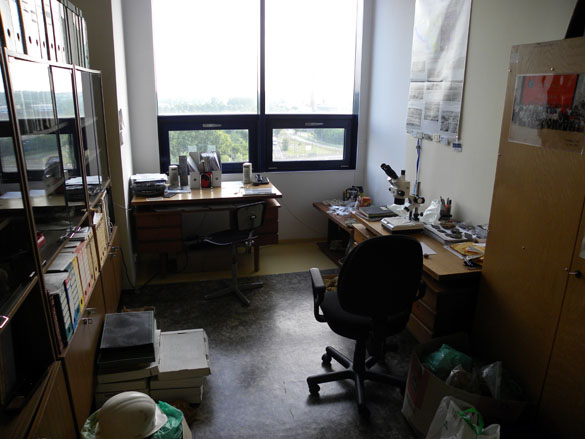 SOSNOWIEC, POLAND–A day in the lab with my colleague Michał Zatoń at the University of Silesia. We sorted through two very different paleontological problems with a microscope and a lot of hand waving. The first task was to come up with a hypothesis about the origin of the strange pitted tubes shown above. They are found on hiatus concretions of the Late Bathonian (Middle Jurassic) exposed in Zarki, Poland. We recently described and analyzed the sclerobionts on and in these concretions (see Zaton et al., 2011), but these tubes remained a mystery. We think now that they are remnants of egg cases laid by gastropods (snails) on the undersurfaces of the concretions, and we’ve started on the manuscript.
SOSNOWIEC, POLAND–A day in the lab with my colleague Michał Zatoń at the University of Silesia. We sorted through two very different paleontological problems with a microscope and a lot of hand waving. The first task was to come up with a hypothesis about the origin of the strange pitted tubes shown above. They are found on hiatus concretions of the Late Bathonian (Middle Jurassic) exposed in Zarki, Poland. We recently described and analyzed the sclerobionts on and in these concretions (see Zaton et al., 2011), but these tubes remained a mystery. We think now that they are remnants of egg cases laid by gastropods (snails) on the undersurfaces of the concretions, and we’ve started on the manuscript.
The coiled encrusting shell below is of a Devonian microconchid originally collected by the keen amateur Brian Bade in western New York and generously donated to our research. This group has some fascinating similarities and differences from its Polish cousins, so we have started a systematic project to determine if they represent a new genus or not. (Brian will be excited to hear this.)
Tomorrow we set off for fieldwork in the area so I’ll post pictures of the wonderful Polish countryside!
Reference:
Zatoń, M., Machocka, S., Wilson, M.A., Marynowski, L. and Taylor, P.D. 2011. Origin and paleoecology of Middle Jurassic hiatus concretions from Poland. Facies 57: 275-300.




